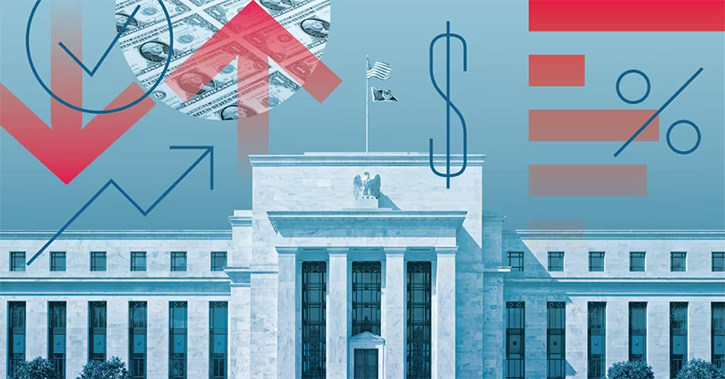Jeremy Glaser: For Morningstar, I'm Jeremy Glaser. As we wrap up the first quarter, I'm here with Bob Johnson, our director of economic analysis, to see if he has changed his forecast for the year.
Bob, thanks for joining me.
Bob Johnson: It's great to be here today.
Glaser: So, as we're sitting here at the end of the quarter, when you look back over the first three months, does it do anything to shift your view of what 2017 will look like from an economic standpoint?
Johnson: So much of our forecast is the same as it was in December. We started the year at 1.5% to 2% GDP growth, and I think we will narrow that range probably a little bit to 1.75% to 2% for the year. And certainly, our big worry remains the consumer who is affected by inflation going up faster than wages beginning to impact some of what's happening there. So, our forecast number is still quite a bit lower than the Street--although the Street has come in considerably from where they were at the beginning of the year where they were well over 2%, even 2.5%. So, clearly, most thinking has come in. Ours is relatively the same with the key worry being what's happening on the consumer front.
Glaser: One of the big questions this quarter was inflation. The Fed raised rates. There was talk of higher inflation. Do you expect any changes this year? What's your forecast there?
Johnson: Well, you know, I've brought in my core inflation forecast a little bit, and that was one of the big changes. I was at 2.4% to 2.6%. I now think it's more likely to be 2% to 2.2%. Clearly, energy prices peaked earlier in the year than I thought. So, instead of happening later in the year, it's happening now. We saw kind of a big spike in inflation--I think we may back off the rest of the year with so much of the price index being moved around by gasoline and then affecting other categories as well. And then in terms of core, I really don't think housing inflation is going to get any worse, which was the key thing driving that core higher. I don't think that's in the cards. So, we've, kind of, brought that in just a little bit. And again, it's not a big deal, but it's certainly not a high inflation number anymore.
Glaser: At the end of the quarter, our stock analyst team goes through every sector, writes an outlook and what they're seeing there. Reading through those reports anything kind of jump out at you, big trends that we're seeing across the economy?
Johnson: Sure. First of all, fitting with our overall trend, they're generally saying that growth is muted in their companies. I mean, nobody is ranting about what great growth they have or how they aren't able to fill capacity. Business is still tight and there's still relatively slow growth.
The other key trend I'd say is a lot of merger and acquisition activity, just a lot. Everything from industrials, consumer--just broad front interest in the mergers. And you'd expect that when you've got industries that aren't growing very fast, you don't need to add brick and mortar, why not buy your competitor instead. And so, certainly, we've seen a lot of interest in M&A, and it went across all of our teams.
One nuance that was a little different is we saw more divestitures this quarter, I think, at least it got more publicity. Certainly, General Motors spinning out their European operations headed that up. But Johnson Controls decided to split some of itself up. So, there's a number of divestitures going on not only this merger and acquisition activity, all just to kind of make capital more efficient because there just isn't a lot of growth out there.
And then of course, the other avenue for earnings growth out there is stock buybacks, and we've seen a lot of companies do their buybacks now. Those generally enhance earnings, although it doesn't do wonders for investor returns.
Glaser: So, let's take a look then at valuations looking across the sectors. Any big shifts there and where value is in terms of stock investing?
Johnson: Yeah, there certainly has been. And overall, the valuations did click up quite a bit here in the first quarter. Overall, we are at 1.06 times fair value for our universe. That's a bit higher than it's been. It usually trends more about 1 and frankly, doesn't usually get a lot higher than 1.08 to 1.10. So, clearly, we're getting in a little bit of a dangerous territory in terms of that number.
The different mix issues were interesting though. Basic materials looks the most overvalued at about 1.4 times fair value and that's certainly been one that's been overvalued for a bit here. Driving those stocks has been a hope that China and the commodity cycle will continue to improve along with Trump's stimulus programs. And certainly, the hopes on those two fronts have really boosted those stocks to probably levels that really aren't sustainable. So, that's one sector that we've got a very extreme view on.
On the other side, we've got healthcare, which is at about 0.98 relative to its fair value, which has still got a lot of issues, regulatory issues, policy issues, pricing issues in front of it. But certainly, with some of the Trump initiatives running into a little trouble here the valuation there is not as extreme as it was. Healthcare was about 13% undervalued at the end of the previous quarter. Now, it's only about 2% undervalued. So, those are kind of the two big extremes there.
Glaser: Overall then it sounds like even if there's not a ton of excitement about growth, there also isn't a lot of fear of upcoming recession or an imminent recession or that there's going to be a big problem with these businesses?
Johnson: Absolutely. I mean, we didn't see a lot of worries in the reports out there. We thought maybe we'd see more worries about trade which we didn't really see a lot of in the reports from the different sectors. We thought we'd see more about the dollar, but we really didn't see anything. In a lot of the reports we've seen like dollar, dollar, dollar and impact on earnings. We really didn't see that this time around. So, a little bit more neutral effect there.
Glaser: If there are fewer values in the market with valuations being a little bit higher, do you see kind of a shift towards economic moats, looking at high-quality companies that you might be willing to pay a little bit more for?
Johnson: Absolutely. Without a lot of growth out there and with valuations being relatively high, our analyst team is generally recommending that people focus on companies with economic moats, that is, companies with competitive advantages. They might make it easier them to get some growth through pricing or through innovation or just defend themselves better and we're therefore focusing more on companies that have these wide economic moats in this time of relatively low growth and high valuations.
Glaser: Bob, thanks for your outlook for the rest of the year.
Johnson: Thank you.
Glaser: For Morningstar, I'm Jeremy Glaser. Thanks for watching.




















